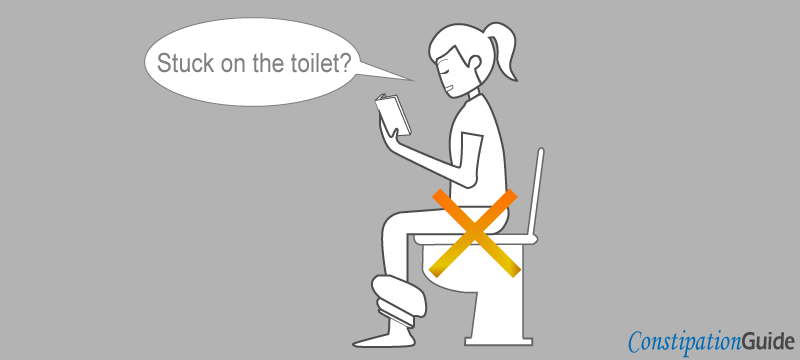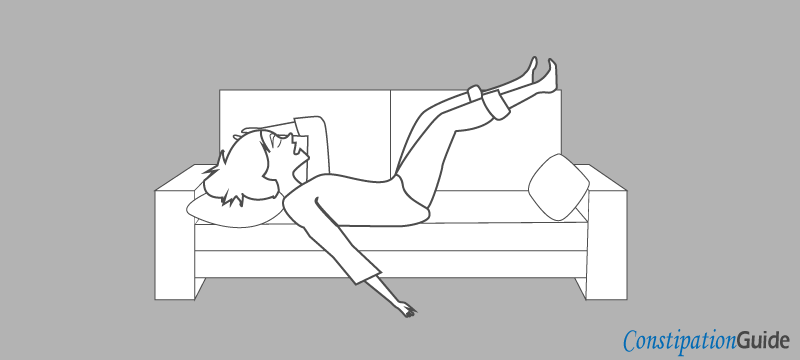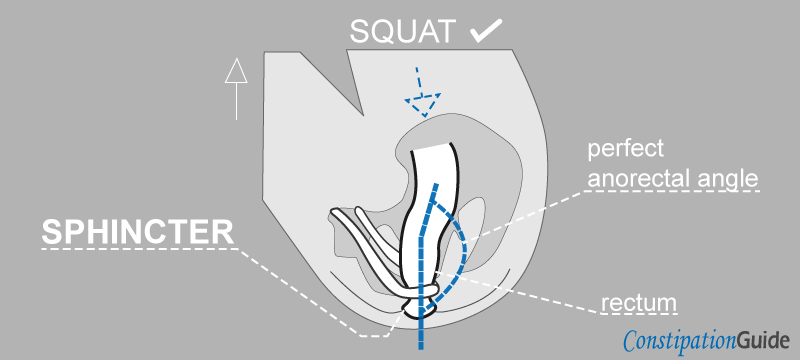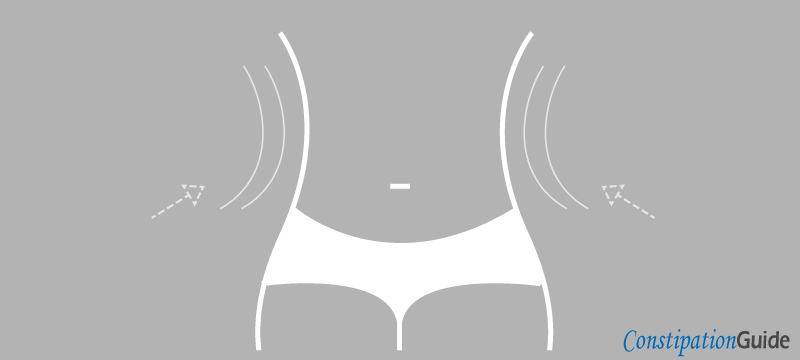STUCK ON THE TOILET WITH CONSTIPATION - 6 GUIDELINES
- Medically reviewed by: Horia Marculescu, MD
- Photo credits: Licenses / Author
- Last updated: 05.01.2024

If you’re stuck on the toilet with constipation, then do the following:
- Step away from the toilet bowl.
- Relax your body entirely.
- Stay in the squat position for 5-10 minutes to relax the anal sphincter.
- Take a laxative if it is necessary.
- Contract and squeeze the rectum.
- Go to the toilet again.
When you feel that you are ready, gently squeeze the rectum. In this way, you will be able to poop smoothly.
Follow the guidelines and prepare your body, know when not to force yourself, and have smooth bowel movements in the long term.
Also, you will know what to do whenever you get stuck again.
1. STEP AWAY FROM THE TOILET BOWL

If you are stuck on the toilet with constipation, step away from the toilet bowl. This thing means that:
- The puborectalis muscles are not relaxed.
- The anal sphincter is relaxed.
- The stool is dry and blocked.
Dry stool sticks to the intestine walls like glue.
A dry stool can block the fecal matter coming from the small intestine.
Usually, your entire bottom (hips, rectum, sphincter, and abdomen) suffers from numbness or soreness.
Also, the anorectal angle is unnatural to unlock the kink at the beginning of the rectum.
Therefore, the stool can't pass through the intestine. So, what you should do is to:
- Step away from the toilet bowl.
- Take a break and relax for 30-60 minutes.
- Do not sit on a chair.
- Try to do some light exercises.
- Come back later.
The idea is to turn your focus away from the toilet and let your body react naturally.
If you are looking for constipation relief, identify the causes first.
Dealing with the causes will make your life better. Dealing with episodic symptoms of constipation is a slow process.
The more you relax your body, the smoother stool evacuation will be.
When you are stuck on the toilet and cannot poop, you must release the tension inside your body, especially in the rectum area.
This thing means to:
- Get rid of all your negative emotions.
- Finish your tasks or study.
- Get rid of stress.
If you continue to feel the need to poop, do not hold it. Go to the toilet and try again. But try it gently and slowly.
“Patients mostly complain of symptoms associated with difficult stool passage, such as the evacuation of hard or lumpy stools or the need for excessive efforts and manipulation during defecation.”
The same health authority mentions that:
“Patients put effort when straining, and the symptoms are associated with hard or dry stools.”
2. FULLY RELAX YOUR BODY

Relax your body whenever you get stuck on the toilet with constipation. Fully relaxing your body helps
- bowel movement
- defecation
- digestion.
Consider eliminating all the causes that create physical fatigue and mental fatigue.
It is difficult to get rid of every negative aspect of our life. It is hard to know what to do when constipated at first. But start small.
Relax your bottom.
Relaxing your bottom means: to not put too much pressure on the puborectalis muscles and anal sphincter.
It also means to get up, do exercise, and walk in your room or outside.
Sitting on a chair for more than 5 hours daily slows blood flow. It also develops muscle numbness or soreness.
Example
If it is Monday and you are at work, try to take a break from work every 60 minutes. And walk for 5 minutes. Also, rest for the next 5 minutes.
Get rid of negative emotions.
Nothing makes you even more stuck on the toilet when constipated than negative emotions. Get rid of everything that makes you feel upset or sad. Stress is a cause of constipation.
Negative emotions and stress affect the nervous system in the tummy area. This thing means that digestion and defecation will not be a priority.
Example
If you have a deadline or an exam, you will go through a period of stress. This thing keeps the brain and the body temperature working at high capacity.
Take short breaks and vacation.
Constipation is a symptom, and it is the result of several causes.
Here are three crucial causes of constipation: stressful scenery, unhealthy eating habits, and improper blood flow.
Go on vacations between stressful work intervals. Go somewhere quiet and full of fresh air once every month.
“General measures are applied for constipation and intestine rest plus antibiotics for pseudo-obstruction. Fecal incontinence is managed with measures for associated SIBO, or constipation, and with behavioral therapies.”
3. RELAX THE SPHINCTER

No one likes to be stuck on the toilet with constipation, especially if the sphincter is not relaxed.
A relaxed sphincter will make you poop because:
- Motility and pressure move the stool toward the rectum.
- The rectum prepares stool for evacuation.
- The rectum opens and evacuates the stool.
Squatting on the floor is an excellent way to relax the sphincter.
Squat for 5-10 minutes and take pauses. After 10 minutes of squatting, the sphincter, the rectum, and the muscles around them should feel relaxed.
You can use the semi-squat posture on the toilet seat.
If you can’t squat on the floor, use the toilet or a chair and lift your feet using:
- foot-stool;
- squatty potty;
- the toes of your feet.
Lifting your feet will help you relax the sphincter and the rectum.
Increasing the anorectal angle by semi-squatting on the toilet is an excellent way to relieve constipation when you visit the bathroom.
You can lift your heel, stick the toes of your feet on the floor, and keep your knees higher. So, stay calm and try to relax your sphincter and rectum.
Medical experts from the International Foundation for Gastrointestinal Disorders state that:
“When puborectalis or external anal sphincter relaxation is incomplete, functional obstruction (pelvic floor dyssynergia, also referred to as anismus) may occur.”
The same medical experts mention that sphincter relaxation is essential for bowel movement. Also, irregularities in muscular relaxation can develop abnormally from birth.
4. TAKE A LAXATIVE

Taking laxatives is a fast way to have smooth defecation. But it is a very short-term relief that can sometimes help us.
Doctors do not recommend the use of laxatives in the long term.
When you’re stuck on the toilet with constipation, it is vital to eliminate the causes first. Keep in mind to eliminate the causes.
There are many over-the-counter laxatives and doctor-prescribed ones. Try to avoid as much as possible medication because it can create dependencies.
What you can do once a year is to
- Take a day off from work or study.
- Take a colonoscopy preparation laxative.
- Have the intestines clean.
This type of laxative empties the intestines, similar to an enema.
It does not have side effects. But it requires eating only liquid foods that day. It is like preparing for a colonoscopy without doing it.
A colonoscopy requires having the intestinal walls cleaned.
You can talk to your doctor about this. It is better to take such a laxative rather than doing an enema.
“Optimal bowel preparation is essential for a more accurate, comfortable, and safe colonoscopy. Laxatives for oral colonoscopy bowel preparation can be classified into polyethylene glycol (PEG, osmotic laxatives, stimulant laxatives).”
“Constipation can usually be treated with medicines called laxatives. Many laxatives are available over-the-counter (OTC). Safe dosing and bowel preparation have the support of The National Colorectal Disease Screening Program. The preparation laxatives divide into high and low volume solutions (≥3 L, (<3 L).”
5. WORK THE ABDOMEN

If you’re stuck on the toilet with constipation, you should start working the abdomen muscles. The tummy is a sensitive area that keeps the small and large intestines in their place.
The purposes of working the abdomen muscles are:
- To move the muscles near the intestines.
- To expand the intestines.
- To move the fecal matter for evacuation.
Working the muscles in the abdomen will make the intestines move and expand involuntarily.
How to do that?
If you are sitting on the toilet, you should start tightening your abdominal muscles slowly.
Take a deep breath and keep the air inside. Push the intestines and the rectum as if you were pooping. Slowly strain for 5-10 minutes.
Do the following:
- Push and shrink your belly to expand slowly.
- Push your abdomen as if you were pooping once every 5 seconds.
- Take a pause.
- Start slowly and increase the pressure gradually using the force of the muscles.
Example
Take a deep breath, keep the air inside, and gently tighten the abdomen for 10 minutes.
If you can’t poop after this time interval, you can repeat the steps for another 5 minutes. You can also work the abdomen by doing any other physical exercise.
According to medical experts from the U.S. Office of Disease Prevention and Health Promotion:
“The first key guideline for adults is to move more and sit less. This recommendation is based on new evidence that shows a strong relationship between increased sedentary behavior and increased risk of heart disease, high blood pressure, and all-cause mortality.”
6. PUSH AND SQUEEZE THE RECTUM
Squeezing your abdomen and rectum as if you were pooping is a practical technique to master whenever you get stuck on the toilet with constipation.
Gently push and squeeze the rectum.
When the rectum gives you a signal that you need to poop, gently strain and contract your abdomen to evacuate the stool.
Keep squeezing the rectum area gently for 1-3 minutes.
If you feel the stool is ready, then push to evacuate it.
You can push stronger if there is a large quantity of stool that you need to evacuate. The feeling is similar to having constipation relief without too much effort.
Do not create too much pressure in the intestines by forcing the abdomen. Squeeze and push harder if you don`t feel any pain or irritation.
Increase the intensity when you feel the sensation. And push the inside slowly.
Push hard if there is enough stool inside ready for evacuation.
Repeat the steps above until your body is ready. It might take more than 15 minutes if you suffer from chronic constipation.
According to a medical study called Pelvic Floor Dysfunction and Refractory Constipation:
“Patients use a broad range of symptoms to describe constipation, including being irregular, having hard stools, as well as a need to strain or apply manual pressure. Defecation occurs using a neurologically series of muscle movements located in the rectum area.”
7. WHAT ELSE HELPS?

Take volume laxatives.
Their effect is almost immediate and will help you poop easily with the techniques mentioned above.
Do not take strong laxatives when you are working. It will protect you from embarrassing situations.
Take bile or pancreatic supplements.
Sometimes, bile and pancreatic supplements are faster than laxatives.
Optionally, take bile or pancreatic supplements if you are stuck on the toilet with constipation.
These supplements help with the enzymes that digestion needs. You will have no problems with stool evacuation.
Do pushups
If you have the luxury to contract your muscles whenever you want to poop, do them.
Doing pushups is good for muscle and bowel movement. And combined with the techniques mentioned above, it will help you poop easily.
Drink hot tea or hot soup.
Hot liquids act differently from bile and pancreatic supplements. Heat causes the muscles and the intestines to force the stool to move quickly.
8. A WORD OF CAUTION
If you get stuck on the toilet with constipation too often, then it is time to visit a doctor.
Also, you should consider:
- Doing more physical exercise.
- Changing your eating habits.
- Replace solid food with more liquid food.
Relaxing your body and the anal sphincter is essential. Having a relaxed state of mind and a healthy body makes pooping easier. A tired body can’t handle smooth defecation.
Last medically reviewed on 05.02.2024
